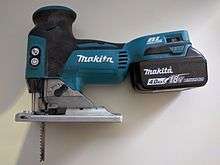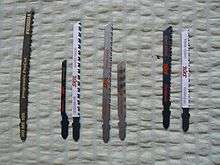Jigsaw (power tool)



A jigsaw power tool is a jigsaw made up of an electric motor and a reciprocating saw blade.
A jigsaw with a bevel function on the sole plate allows cutting angles of typically up to 45 degrees relative to the normal vertical stroke for cutting miter joints.
In the past, what are now usually called scroll saws were often referred to as jigsaws.
A power jigsaw may also be referred to, by some manufacturers, as a "bayonet saw" or sabre saw.
History
In 1946 Albert Kaufmann, an engineer of Scintilla AG company in Solothurn, Switzerland, replaced the needle on his wife's sewing machine with a saw blade.[1][2] In 1947, after development of Kaufmann's invention, Scintilla started producing jigsaws under name "Lesto jigsaw". In 1954 Scintilla was acquired by Bosch and in 1964 the name "Lesto" was replaced with Bosch. Bosch has since innovated the tool and added pendulum blade action, tool-less blade replacement, and CutControl.
Blades
A Jigsaw works by attaching a blade accessory to the tool. There are various types of blades in the market. Most jigsaws require a blade to be screwed into the tool, but Bosch has since added the first tool less blade change system allowing a blade to be snapped into the tool.
There are T-shank blades and U-shank blades available in the accessory market. T-Shank blades are the industry-standard professional interface that provides a longer life and a tighter fit from the blade to the tool.
Tooth design is important for the performance of a blade. The tooth spacing, tooth shape, and cutting angle are important in providing speed, cleanliness of cuts, and optimal performance. A side set and ground tooth is designed for clean and fast cuts in wood and plastics. Wavy set and milled teeth will cut most metals as well as aluminum and plastics. A side set and milled tooth works with fast and rougher cuts in wood and plastics. A ground and taper ground tooth is for very precise, fine and clean cuts in wood. There is also reduced-kerf carbide and diamond grit edges for fast cutting in hard materials.
Blade Material
It’s important to match your blade material to the type of application you might be doing. Not only is blade life optimized but the performance of the tool is enhanced.
High-carbon steel (HCS) due to its flexibility is used for softer materials such as wood, laminated particle board and plastics.
High-speed steel (HSS) is a stronger metal that can cut all types of metals and aluminum.
Bi-Metal (BIM) is a combination of high-carbon steel and high-speed steel. The combination creates a strong and flexible material that is built for demanding applications when there is a risk of breakage or when extreme flexibility and versatility is required in an application. Bi-Metal has a longer life span and prolonged job performance.
Tungsten carbide (TC) blades have the strength to cut through abrasive metals such as reinforced plastics, fiberglass, cement board, stainless steel, tile, glass, cast iron, and brick.
Diamond grit blades are extremely versatile. They can cut various rough materials due to their finely milled particles. They can cut the same materials as carbide blades but their lifespan is extended. The blades can also cut through hard porcelain tile, granite, slate, marble, and other stones.
Controllability
Control is an issue with jigsaws. The blades are small, weak and entirely unsupported at the lower end. Good cut control requires the presence of blade rollers, which keep the blade aligned just above the sole plate. Heavy cast sole plate saws are somewhat better than pressed steel for sawing line control too. To guide a jigsaw on curved cut, it must be steered (turned) and not forced to move sideways. The use of sharp blades is important as well to get high quality cuts.
References
External links
| Wikimedia Commons has media related to Jigsaws. |